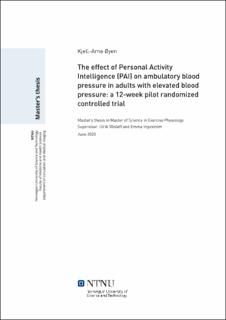| dc.description.abstract | Background: High blood pressure (BP), or hypertension, is estimated to affect over one billion individuals worldwide and is considered a leading risk factor for cardiovascular disease. Low cardiorespiratory fitness is independently associated with all-cause mortality in hypertensives. Regular physical activity is routinely recommended in the prevention, treatment and control of hypertension. Personal Activity Intelligence (PAI) is a physical activity metric where obtaining ≥100 PAI per week is associated with longer life, higher fitness and lower incidence of hypertension compared to peers obtaining 0 PAI per week. The primary objective of this randomized controlled pilot trial was to evaluate the effect of a physical activity goal of ≥100 PAI per week compared to following current physical activity guidelines on 24h ambulatory BP (ABP) in adults with elevated BP. Secondary outcomes include automated office BP, arterial stiffness, cardiac function and cardiorespiratory fitness.
Methods: This 12-week parallel two-arm pilot trial took place in Trondheim, Norway (October 2019 to May 2020). Twenty-six inactive (<50 PAI per week based on self-reported physical activity) but otherwise healthy adults (45-64 years), meeting the automated office BP criteria of 130-179 mmHg systolic and/or 80-109 mmHg diastolic BP, were recruited (50% women). Participants were randomized (1:1) to an intervention group (n = 12), that were instructed to obtain ≥100 PAI per week guided by a heart rate monitor with a PAI app, or to a control group (n = 14), recommended to follow current physical activity guidelines. Both groups were equipped with a heart rate monitor tracking PAI, but only the intervention group was aware of their PAI level during the intervention period. The primary outcome was assessed with 24h ABP monitoring, and the secondary outcomes were measured by automated BP readings at the clinical office, carotid-femoral pulse wave velocity (cf-PWV), stroke volume by echocardiography and peak oxygen uptake (VO2peak) during cardiopulmonary exercise testing. The outcome measures were assessed at baseline and after 6 and 12 weeks, and subsequently analyzed using linear mixed models on an intention-to-treat and post-hoc basis comparing participants who obtained ≥100 PAI per week to those who obtained <100 PAI per week (on >70% of the days in the intervention period).
Results: The average 24h systolic and diastolic BP was 135 and 81 mmHg, respectively, at baseline, with an average body mass index of 28 kg/m2 and VO2peak of 36 ml/kg/min. We observed no differences between the intervention (n = 10) and the control group (n = 13) in 24h ABP, automated office BP, cf-PWV, stroke volume or VO2peak following 12 weeks. There were no significant differences between participants who obtained ≥100 PAI on at least 70% of the days compared to those who did not on any outcomes except on automated office systolic BP, which was 7.5 mmHg (95% Confidence interval (CI) -14.2 to -0.8) and 6.4 mmHg (95% CI -13.5 to 0.8) lower in those who achieved ≥100 PAI following 6 and 12 weeks, respectively.
Conclusions: Our findings indicate that there is no difference in 24h ABP between the intervention, obtain ≥100 PAI/week with PAI monitoring for 12 weeks, compared to the control, recommended to follow current physical activity guidelines. Obtaining ≥100 PAI/week may be effective in reducing automated office BP but not 24h ABP. No change in 24h ABP and VO2peak indicate that future PAI trials should examine the effect of higher PAI levels and look for ways to increase adherence.
Trial registration: Clinicaltrials.org identifier: NCT04151537.
Funding: The present study is a part of the My Medical Digital Twin (MyMDT) project, which is funded by NTNU through the Digital Transformation Initiative. | |
